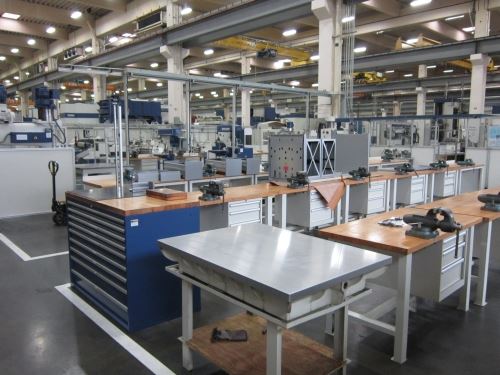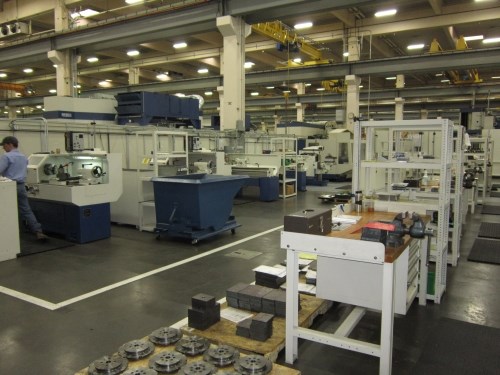All-In for Apprentices
The apprenticeship program at Grob Systems offers a free associate’s degree, a paycheck and the possibility to launch a manufacturing career with the company.
Share





Ever heard of Bluffton, Ohio? It’s a small village in the rural northwestern part of the state with an approximate population of 4,000. It’s also home to Grob Systems, the U.S. branch of Germany-based Grob Group, builder of universal machine tools and flexible automotive production systems.
Grob Systems was founded in 1983 as a sales and service division for the U.S. market. Bluffton was chosen because it was centrally located among a number of the company’s automotive customers. Grob Systems added manufacturing capacity there in 1991, and its operation has grown to 400 employees and a 323,000-square-foot facility where automotive production systems and related equipment are manufactured.
While the location is ideal in terms of customer support, there isn’t a deep pool of experienced manufacturing personnel to tap nearby. Therefore, the company established a paid apprenticeship program from the get-go, largely based on its parent company’s model. Today, the program is led by training supervisor Mike Hawk, who has initiated changes that have enticed more young people to consider applying. Perhaps the biggest change came in 2012. That’s when the potential to receive a journeyman’s card through the program was replaced with the ability to earn an associate’s degree—at no cost to the apprentice.
Simply put, the program offers an opportunity to learn a trade and get a degree in manufacturing engineering for free through nearby Rhodes State College, while earning a paycheck.
This change represents a necessary progression for the company’s apprenticeship model here in the States, Mr. Hawk contends. “How many kids (or parents) know what a journeyman’s card is? On the other hand, they’re certainly familiar with an associate’s degree,” he explains.
The change seems to be paying dividends. Last year, the company received more than 100 applications, which is three times as many as it would get when a journeyman’s card was offered. Mr. Hawk and other Grob Systems representatives frequently visit schools in a 50-mile radius of the company’s campus, and the company currently has more than 25 feeder high schools for its program.
So how does it work? First, the grades must be there. Mr. Hawk looks for applicants with a GPA of 3.0 or higher who are particularly good at math and, perhaps more importantly, have excellent attendance records. Applicants also must complete a Rhodes-administered aptitude test covering a variety of mechanical and electrical engineering basics. After considering all of that information (background and drug tests are also administered), Mr. Hawk then selects a new batch of apprentices to hire. The program adds 15 or more apprentices each year, and it takes 3.5 years for each apprentice to graduate.
Those who are chosen for the program can pick school tracks in either electrical engineering technology or mechanical engineering technology. The apprentices attend Rhodes two days per week and work at the company’s facility the other three days. The work program at Grob Systems has apprentices cycling through various plant production and assembly areas. They spend eight weeks in areas including machining, fabrication and electrical, enabling them to identify what type of work they like best. Supervisors evaluate students’ progress every two weeks. Those who score highest in their final evaluation have first dibs on requesting in which area they would like to work after completing the program. Mr. Hawk compares students based on a mean evaluation score, so people are average, below it or above it. Being average is fine because that’s where they are expected to be, which is why he believes it’s unfair to compare one apprentice to another. That can cause an average person to look bad when compared with someone who is really excelling.
The projects the apprentices complete at the facility are not busywork. Apprentices are not performing mundane duties such as grinding high-speed steel cutters, for example. Instead, they are most often making actual parts to support the company’s production needs.
To date, the number of people who have completed the program and are working at Grob Systems combined with those currently in the program is 239. This demonstrates that while the program represents a significant investment on the company’s part, including an apprentice workshop and machining area that has manual mills as well as two CNC turning centers and two VMCs, the investment is paying dividends. And what’s interesting is that the company has never placed a target number for how many jobs it is looking to fill. Its goal is have a continuous program yielding a continuous stream of smart prospects.
Grob Systems’ efforts represent the nature of U.S. manufacturing today in which manufacturers really have no option other than developing talent in-house. That said, it is disheartening, but not surprising, that Mr. Hawk still encounters high school guidance counselors who tend to push students with lower grades toward manufacturing careers. However, he wants the bright ones. All U.S. manufacturers need the bright ones.
Related Content
Manufacturing Madness: Colleges Vie for Machining Title (Includes Video)
The first annual SEC Machining Competition highlighted students studying for careers in machining, as well as the need to rebuild a domestic manufacturing workforce.
Read MoreInside Machineosaurus: Unique Job Shop with Dinosaur-Named CNC Machines, Four-Day Workweek & High-Precision Machining
Take a tour of Machineosaurus, a Massachusetts machine shop where every CNC machine is named after a dinosaur!
Read MoreFinding the Right Tools for a Turning Shop
Xcelicut is a startup shop that has grown thanks to the right machines, cutting tools, grants and other resources.
Read MoreWorkholding Fixtures Save Over 4,500 Hours of Labor Annually
All World Machinery Supply designs each fixture to minimize the number of operations, resulting in reduced handling and idle spindle time.
Read MoreRead Next
Registration Now Open for the Precision Machining Technology Show (PMTS) 2025
The precision machining industry’s premier event returns to Cleveland, OH, April 1-3.
Read More5 Rules of Thumb for Buying CNC Machine Tools
Use these tips to carefully plan your machine tool purchases and to avoid regretting your decision later.
Read MoreSetting Up the Building Blocks for a Digital Factory
Woodward Inc. spent over a year developing an API to connect machines to its digital factory. Caron Engineering’s MiConnect has cut most of this process while also granting the shop greater access to machine information.
Read More




















.jpg;maxWidth=300;quality=90)












